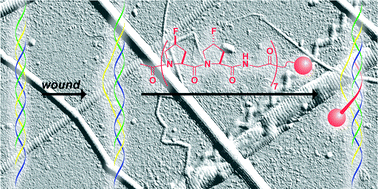Peptides that anneal to natural collagen in vitro and ex vivo†
Abstract
Collagen comprises ¼ of the

- This article is part of the themed collection: Organic & Biomolecular Chemistry 10th Anniversary
Maintenance work is planned for Wednesday 1st May 2024 from 9:00am to 11:00am (BST).
During this time, the performance of our website may be affected - searches may run slowly and some pages may be temporarily unavailable. If this happens, please try refreshing your web browser or try waiting two to three minutes before trying again.
We apologise for any inconvenience this might cause and thank you for your patience.
* Corresponding authors
a Department of Chemistry, University of Wisconsin–Madison, 1101 University Avenue, Madison, WI 53706, USA
b Department of Surgical and Radiological Sciences, School of Veterinary Medicine and Department of Ophthalmology and Vision Science, School of Medicine, University of California, Davis, Davis, CA 95616, USA
c Department of Surgical Sciences, School of Veterinary Medicine, University of Wisconsin–Madison, 2015 Linden Drive, Madison, WI 53706, USA
d
Department of Biochemistry, University of Wisconsin–Madison, 433 Babcock Drive, Madison, WI 53706, USA
E-mail:
rtraines@wisc.edu
Collagen comprises ¼ of the

 Please wait while we load your content...
Something went wrong. Try again?
Please wait while we load your content...
Something went wrong. Try again?
S. Chattopadhyay, C. J. Murphy, J. F. McAnulty and R. T. Raines, Org. Biomol. Chem., 2012, 10, 5892 DOI: 10.1039/C2OB25190F
To request permission to reproduce material from this article, please go to the Copyright Clearance Center request page.
If you are an author contributing to an RSC publication, you do not need to request permission provided correct acknowledgement is given.
If you are the author of this article, you do not need to request permission to reproduce figures and diagrams provided correct acknowledgement is given. If you want to reproduce the whole article in a third-party publication (excluding your thesis/dissertation for which permission is not required) please go to the Copyright Clearance Center request page.
Read more about how to correctly acknowledge RSC content.
 Fetching data from CrossRef.
Fetching data from CrossRef.
This may take some time to load.
Loading related content
